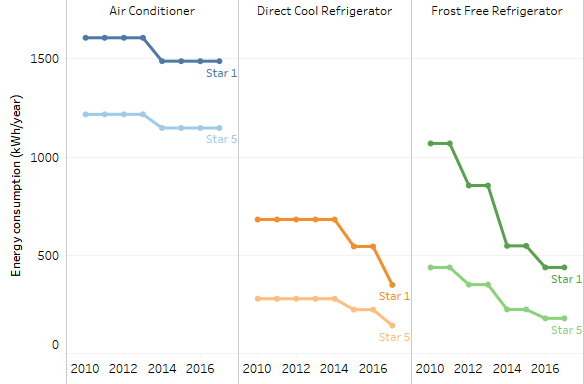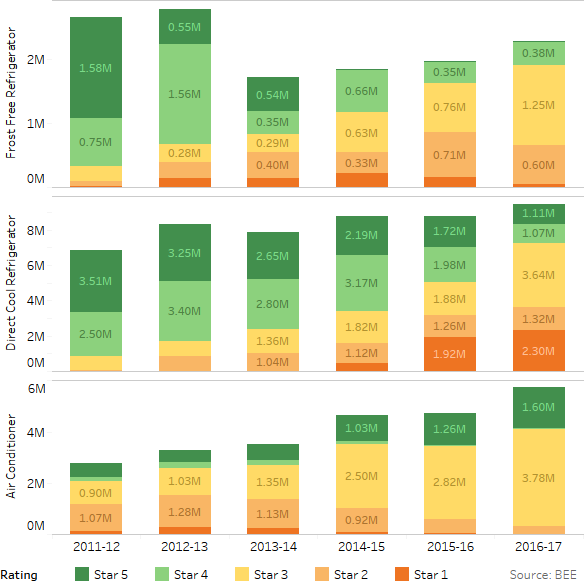
This is the fifth post in the blog series “Plugging in: Electricity consumption in Indian Homes” by Prayas (Energy Group) and Centre for Policy Research (CPR).
A small set of appliances such as fans, televisions, refrigerators, air-coolers, air conditioners, and water heaters contribute about 50-60% of the total residential electricity consumption in India. Large scale adoption of energy efficient models of these appliances can thereby significantly reduce future electricity consumption in homes. In this post, we look at the government’s Standards and Labeling (S&L) programme and three aspects of its effectiveness in achieving efficiency in the Indian appliances market.
The S&L programme is run by the Bureau of Energy Efficiency (BEE), under the Ministry of Power. Since 2006, the programme promotes efficient appliances through informative labels and by eliminating lower efficiency models through mandatory standards. BEE gives a 5-star rating to the most efficient models and a 1-star rating to the least efficient ones based on a pre-determined schedule, communicated through a label affixed on the appliance (Figure 1). Eight appliance categories, including air-conditioners and refrigerators are mandated to carry these labels, and no model can be sold unless it meets the 1-star rating, at minimum. The programme is voluntary for 13 appliance categories, including ceiling fans and washing machines, and manufacturers can sell these models without BEE labels and with an efficiency less than a 1-star rating.

Figure 1: BEE star label for air-conditioner
Mandate and tighten standards
For any appliance, BEE starts with a voluntary S&L programme and usually makes it mandatory in two-three years. BEE’s mandatory list has increased from two to eight and now covers most major appliances including, refrigerators and air-conditioners (Figure 2). Ceiling fans and air-coolers are notable exceptions. More than 95% of the ceiling fans sold do not carry labels and consume more than twice the most efficient model available in India. The programme has been voluntary for ceiling fans since 2010. Air-coolers guzzle much more electricity and are increasingly becoming popular but have not yet been included in the S&L programme. Making a programme mandatory for an appliance category ensures that inefficient models are not sold in the market.
Mandatory Appliances |
Voluntary Appliances |
|
Frost Free Refrigerators |
Induction Motors |
|
Tubular Fluorescent Lamps |
Agricultural Pump Sets |
|
Room Air Conditioners |
Ceiling Fans |
|
Distribution Transformers |
Domestic LPG stoves |
|
Room Air Conditioners (Cassette, Floor standing, Tower, Ceiling) |
Washing Machine |
|
Direct Cool Refrigerators |
Computer |
|
Electric Geysers |
Ballast |
|
Colour TV |
Office Equipment |
|
|
Diesel Engine Driven Moonset Pumps for Agricultural Purposes |
|
|
Solid state inverters |
|
|
Diesel Generators |
|
|
Variable capacity air conditioners |
|
|
LED lamps |
Figure 2: List of appliances on the Standards and Labeling (S&L) Programme
BEE also periodically tightens the standards and labels to keep up with and promote the most efficient commercially available technologies. So, today’s 5-star model may become a 3-star model in the next phase and more efficient models can get the new 5-star tag. BEE has periodically tightened ratings for frost-free refrigerators and the current 5-star ratings are comparable with international standards, but the 1-star rating still has a scope for improvement. The ratings for air-conditioners on the other hand can be tightened further to align with the most efficient models available in India as well as abroad (Figure 3).

Figure 3: Tightening of star-labels for different appliances. (Approximate of typical appliances: 1.5 ton air-conditioner, 200 litre direct cool refrigerator and 300 litre frost-free refrigerator.)
Source: BEE with authors’ assumptions for usage
Nudges and bulk procurement programmes
Mandating and tightening star-ratings is necessary but may not be sufficient for large scale adoption of energy efficient appliances. For example, appliance production data shows a significant drop in the production of 5-star rated frost-free refrigerators after tightening in 2014 and 2016 (Figure 4). Also, the share of 3-star models is the highest in most of the appliance categories.
To promote 5-star rated appliances, complementary approaches like behavioural interventions and bulk procurement programmes can be useful. Consumer behaviour research shows that consumers, faced with a menu of options, often simplify their decision making by choosing an option that resembles a ‘middle’ or ‘compromise’ option. Is this resulting in people buying more 3-star rated models? Can this be addressed by designing interventions that can nudge people towards buying more 5-star rated models? BEE’s recent app to estimate monetary savings from an efficient appliance helps consumers in understanding the labels. More such initiatives can be effective.

Figure 4: Appliance production across star-labels (in millions)
Source: BEE
Bulk procurement programmes (similar to UJALA for LED bulbs) can also help in market transformation to energy efficient appliances. These programmes can incentivise the production of the most efficient appliances (beyond 5-star) to pull up efficiency levels in the market. BEE can then further push market efficiency up by tightening standards. The programmes can smoothen the transition phase to higher standards and labels. However, one needs to be cautious about the rebound effect where consumers buy more appliances because the programme has made buying and using them cheaper thus negating the expected savings.
Credibility of the S&L programme
A final point is regarding the credibility of the S&L programme. Transparency in the standards setting process and ensuring conformance with the standards is important to strengthen credibility. BEE has recently taken positive steps in this direction. It published proceedings of the technical committees that set the standards and labels, and data on appliances production across various categories is now available on the BEE website. Going ahead, BEE can also publish the check-testing results it is supposed to conduct on a random sample of appliances collected from the market. A periodic testing for conformance with the standards can significantly increase the consumer trust in the labels. If the models do not comply with the standards, BEE can publish the results in newspapers to warn consumers, as it has done once in the past.
To summarise, the Standards & Labeling Programme can effectively improve the efficiency of India’s household appliances, as discussed in this post. However, this is a resource intensive activity. Given the limited resources, BEE can instead prioritise a smaller number of appliances with rigorous implementation, rather than adding more appliances to the programme.
In the next post, we examine the appliances owned within affordable housing, and the extent of their energy efficiency.
This piece is authored by Aditya Chunekar and Mrudula Kelkar at the Prayas (Energy Group).
This blog series is also available on the Centre for Policy Research website.

